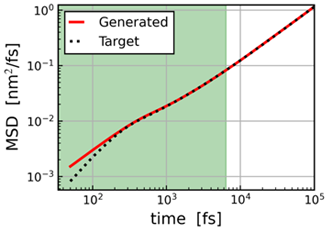- Data Science
- Small molecule penetration / diffusion / adsorption
- Materials Science
- Life Science
[Analysis Example] Prediction of Long-Time Molecular Motions Using MD-GAN
Based on the results of short-time MD calculations, MD-GAN (machine learning) is used to predict long-time molecular motions and evaluate diffusion phenomena.
Molecular dynamics calculations can be used to evaluate a wide variety of physical quantities and properties, such as diffusion coefficients. On the other hand, it is necessary to follow the dynamics of molecules, which requires calculation time to handle long time phenomena.
MD-GAN, developed by Yasuoka Laboratory at Keio University (http://www.yasuoka.mech.keio.ac.jp/english/index.php), makes it possible to predict long-time molecular motions based on short-time molecular dynamics data.
 Fig.1. Prediction of long-time molecular motions by using MD-GAN
Fig.1. Prediction of long-time molecular motions by using MD-GAN
While the references deal with complex subjects such as polymer dynamics [1] and diffusion of Li ions in all-solid-state batteries, here we present a simpler subject: the results of diffusion behavior of water and benzene in bulk.
Figure 2 shows the mean square displacements (MSD) of water and benzene molecules. The MD calculation results (black dotted line) in the short-time region (green) were used to obtain the solid red line by MD-GAN. Although a slight difference can be seen in the short-time region, there is a good agreement in the long-time region (white area), which is outside of the training data.
For verification purposes, this time, the MD-GAN results were compared with the MD calculation data in the long time region as well, and it was shown that the MD-GAN can provide good results. On the other hand, the results suggest that MD-GAN can be used to predict "longer time phenomena that are difficult to achieve by MD calculations," which is considered to be an actual need.

![Fig.2: The relaxation time tau [ps] obtained from the fitting plotted against 1/T [K-1]](./img/caseA52_img03.png)
Fig. 2. MSD predicted by MD-GAN (left: water, right: benzene).
The black dotted line is the MD calculation result and the solid red line is the prediction result by MD-GAN.
MD-GAN is performed using the data in the short-time region (green) of the MD calculation results.
Molecular motion is well predicted in the long time region (white).
MD-GAN is available as an optional feature of J-OCTA. As mentioned above, it can be applied to various targets. Please feel free to contact us if you are interested.


